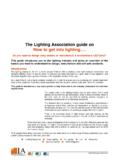Transcription of Schools' buying strategy - assets.publishing.service.gov.uk
1 Schools buying strategy January 2017 Contents Summary 3 Who is this publication for? 3 Main points 3 The case for efficiency 3 Overall support on efficiency 3 Schools buying strategy 4 Key aims and initiatives 5 Practical support available now for schools and school business managers 6 User research summary 9 Strategic aims 10 Skills and relationships 10 Smart consumers 10 Buyers have access to the best value every time 11 Guiding principles 12 Key initiatives 12 Access to buyers networks and help with more complex buying 13 Local SBM Networks 13 Helping with complex buying 13 Departmental focus areas 17 Greater professionalisation of school business management 17 Enhanced communication with the sector 17 Annex A: 2020 Delivery user research 18 Initial user research understanding the situation on the ground 18 Headteachers 18 Teachers 18 Governors 18 Suppliers 19 Response to the strategy 20 Survey Findings 21 2 Summary The schools buying strategy is intended to support schools to save over 1 billion a year by 2019-20 on their non-staff spend.
2 It aims to help all schools improve how they buy goods and services allowing them to maximise the resources they can invest in high-quality education for their pupils and supporting them in managing cost pressures. Who is this publication for? This strategy is aimed at: all financial staff in schools including school business managers (SBMs), finance directors and bursars headteachers and other school leaders academy trust and school governing bodies Main points The case for efficiency Effective schools make the best use of resources ensuring every pound is used efficiently to improve standards and have maximum impact for their pupils. This means planning educational improvement and finances together. Managing school finances is not an additional responsibility or requirement it is intrinsic for each and every high-performing school.
3 Effective school leaders know this is a key part of their role, and taxpayers across the country expect nothing less. At the same time, like many organisations, schools are facing pressures for example from pay increases and employers contributions to National Insurance and pensions. On a per pupil basis, these pressures are estimated at around 8% by 2019-20. We are committed to helping schools make efficiency savings to help manage these pressures, while continuing to improve standards for their pupils. Overall support on efficiency We know that the current outdated and unfair funding system, rooted in historic decisions taken in the 2000s and before, makes it harder to make the best use of resources. We are introducing a National Funding Formula to give greater certainty on funding and allow schools to plan ahead effectively; and to ensure that resources are matched fairly and consistently across the country to school and pupil need.
4 We are also committed to providing support for schools to make savings. In a school-led system, the decisions on how to use available resources must be for schools. Schools will work directly with other schools to achieve greater efficiencies, whether through Multi Academy Trusts (MATs) or through individual schools working together to negotiate 3 deals and share services. But the department has an important role, working with the sector, to build capacity and provide the right tools, guidance and resources. We have already published a wide range of tools and support available in one place. This includes support for schools to review their level of efficiency; investigate levels of spend against other similar schools; and take action to improve efficiency in practice.
5 We are also bringing together support on overall school improvement , including support for improving schools use of resources and financial health. In 2017-18, 140 million in funding will be available to support strategic school to school improvement across education, targeted at where it is most needed as we progress towards a fully school-led system. To build school capacity in leadership and governance, the department also launched the Regional Academy Growth Fund in October 2016. This aims to support the growth of successful trusts and to increase capacity to raise standards in underperforming schools. This will continue to allow trusts to expand to achieve efficiencies through economies of scale and shared procurement, supported by formal joint-governance structures.
6 Schools buying strategy We are now launching a schools buying strategy to support schools to save over 1 billion a year by 2019-20 on their 10 billion of non-staff spend. In addition to the tools, guidance and support the department already provides for schools, there is more we can do. In procuring a wide range of goods and services in often complex marketplaces, we know schools can face higher costs than they need to, losing money which could be better spent on directly improving high-quality teaching and achieving better educational outcomes for their pupils. Schools need to buy a wide range of goods and services and they may use different suppliers, such as public sector buying organisations (PSBOs), procurement consultancies and local authority (LA) traded services, to help them do so.
7 This diversity can offer opportunities for schools to improve their efficiency. But provision of services is patchy, both geographically and in terms of value for money. Buyers in schools want and need to save money, but struggle to do so. The fragmented system is not built around their needs. We want to help schools to reduce the complexity and provide greater transparency and advice to signpost buyers to the right place, right product or service every time. Informed directly by schools and building on best practice across the sector, the schools buying strategy includes a range of initiatives that will: 1. Ensure buyers in schools have the right relationships and skills building peer-to-peer support networks and creating regional advice and guidance services to help with complex buying 4 2.
8 Support schools to be smart consumers providing practical help and advice on buying decisions and contract management 3. Ensure buyers have access to the best value every time giving schools access to better deals, for example on energy, printers and photocopiers, and using digital opportunities to make buying easier The diagram below provides a summary of the strategic aims, guiding principles, and specific initiatives which are set out in more detail in the strategy . Key aims and initiatives 5 Practical support available now for schools and school business managers There is already a wide range of tools and support on efficiency available to schools in one place. This includes the following elements. 1. Tools for schools to assess their level of efficiency and investigate particular lines of spend to find opportunities for savings.
9 An efficiency metric indicates how schools efficiency compares to similar schools, a benchmarking report card encourages comparisons of spending data between similar schools, and a top-ten checks list provides guidance as to the types of questions governing bodies may wish to ask their school leadership teams relating to financial health. 2. Guidance on best practice. Guidance videos cover topics such as strategic financial planning and collaborative buying , and individual case studies from schools themselves set out real life examples of how they have improved their levels of efficiency whilst continuing to focus on delivering outcomes for pupils. On each case study, there are contact details available so that schools can link up with the person who led delivery of concrete savings in these examples.
10 3. Support for schools to access greater financial skills. The financial health checks structure is designed to help schools identify what support they need to become more efficient. There are three levels of check a 1 to 2 day review designed for schools or trusts that require a short review of their financial position; a 3 to 5 day review to address specific issues or future budget pressures identified by schools or trusts; and a 6 to 10 day review to provide in depth support to plan and deliver change for schools and trusts if in financial difficulty. The website includes a directory of some of the suppliers that can provide these checks. This support can help schools review their current financial position, as well as identify issues and take appropriate action to address them.












